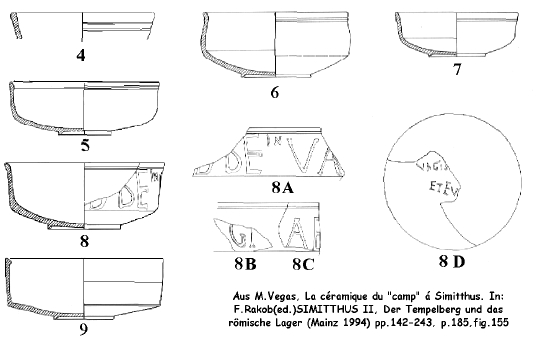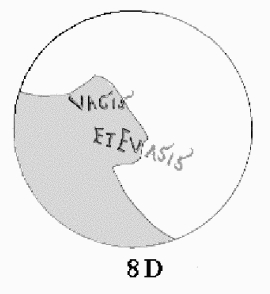|
From air photographs, the functional and administrative complex (fabrica?) of the Marmora Numidica at Simithu-Chimtou was at least tripartite. *) From W to E it contained: 1.-A rectangular and hitherto unexcavated compound, suspectedly converted from a first Roman army casernment under Augustus (praesidium *) into well fitted living quarters for the skilled marble artisans hired as paid labour (called mercenarii - as in the Roman mines of Spain?). 2.-A carefully walled and secured block of 6 halls as quarters for people sentenced to forced labor in the Imperial quarries or slaves forcefully brought here for the same purpose (a building called ergastulum by ancient authors and excavator F.Rakob *). 3.- Its Eastern flank is covered by the 3rd. annex, visible in an air photograph: a walled square arrangement of barracks (and horse stables?) with typical rounded corners of a Roman fortlet (praesidium ? *) No signs of turrets or towers along curtain walls measuring approx. 30 by 30 ms flanks.
 1. On the inside of a bottom fragment No.8D, a scribble of 2 lines can be read. It was incised (,graffito") into the unbaked vessel while it was drying in the potter's shed and dipped after incision into the typical red TS-Chiara slip before it went to the kiln. This can only mean: the bowl was selected halfway during the potting process by somebody who had it dedicated on demand by a graffito "ante cocturam" reading: Considering the intended dedication vagis and the Latin vocabulary with only a few words beginning with ev... - the phrase leaves hardly another chance for completion than EV[ASIS]...
In all probability drinking companions which drunk in the round ("the Greek way" - more Graeco) from a bowl containing about 1 litre (ca.30 fl.ozs) of liquid
arrived "bottom up" to read: 
2. On the outer rim, scratched through the red coating down into the light buff inner clay after firing (thus, this graffito being technically a ,sgraffito"), in fig.2 there is a series of letters :
It was M.Hartmann, who discovered during our installing the museum, that fragm. 8A and fragm. 8B fitted clearly together, thus enlarging the phrase on them to: BB IN VAGI. Vegas (p. 185) had already seen that vagi appeared as well on the outside as on the inside. There is a possibility that the
shortly pronounced "i" in bibe was put as a smaller "I" between the two B's. As a sort of I brevis) just like the word IN behind the E or attached onto the 2nd. "B".

It is corroborated by numerous parallels, that vessels with such ante cocturam - graffiti were made to order of an individual or a group, which had the inscription incised before purchase as a motto for future users of the vessel. The post cocturam-sgraffito on the rim with its command:"(Drink to) the....of a stroller..", however, whichis obvious invitation to the recipient, when the bowl was offered to him for a swig in the round, could have been applied well after its first use. But what would vagi have to tell us? Roman use provides the word e.g. for nomad tribes of the area-Gaetuli vagi. Certainly, the emperor's manager of the Chimtou quarries (procurator Augusti marmorum Numidicorum) would not pay a bowl of wine or a meal, let alone a reward in money, to catch groups of nomads in the region. They were around, coming up from the northern Sahara shore to graze their flock in the fields every year after the grain harvest. And they continue still today in Central and Northern Tunisia and Algeria. There might be a greater chance that a reward was payed to the guard soldiers for bringing in next to runaway inmates individuals who could not prove a legal residence. There is evidence in the history of Roman law for both cases. It should have been on occasions of reward to the mounted platoon of soldier wardens, that the bowl circulated among them.
*) These comments are based based on the reports ed. by Friedrich Rakob, SIMITTHUS II,Der Tempelberg und das roemische Lager (Mainz 1994). |